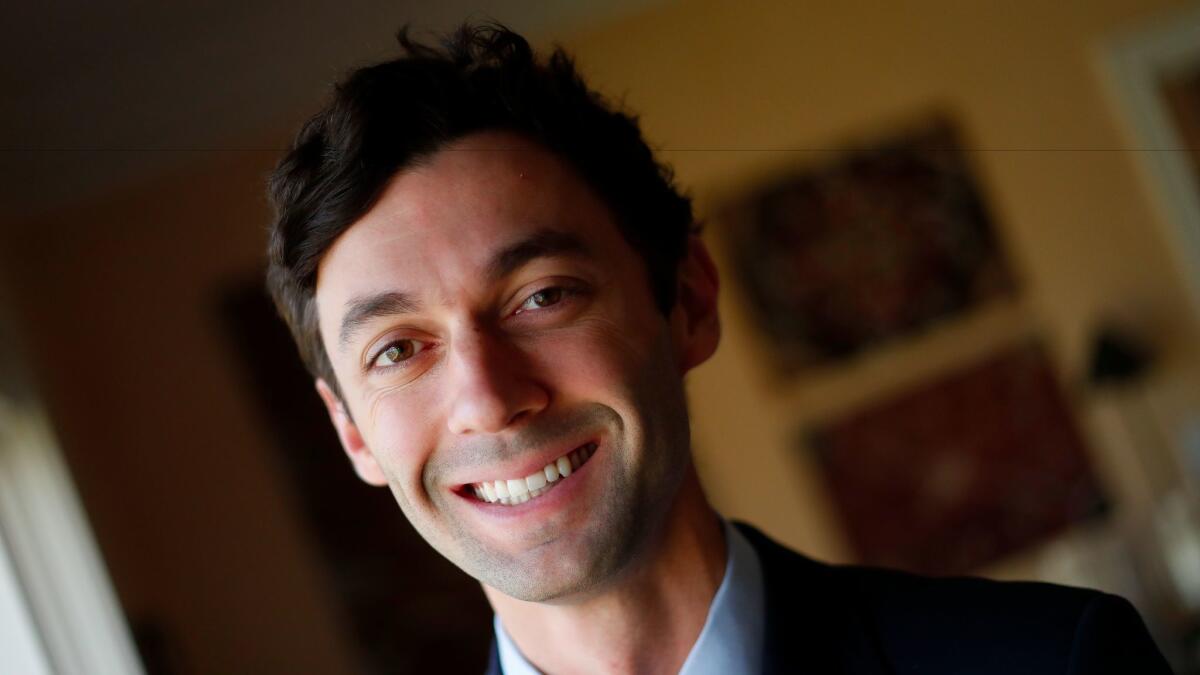Democrats see a path to salvation in the Sunbelt — and Newt Gingrich’s backyard

Reporting from Washington — As political activists around the nation watched Democrats bicker in Atlanta last weekend over who should take the party’s helm, a less noticed drama got underway in the nearby suburbs, one that ultimately may signal whether the party can emerge from its funk.
Georgia Democrats, who have been getting creamed for years in the towns stretching north of Atlanta, believe they are within striking distance in a special election that will choose a replacement for Tom Price, the former member of Congress tasked by President Trump with dismantling Obamacare as his Health and Human Services secretary. Voter distaste for Trump, the evolution of the new Sunbelt suburban electorate and a 30-year-old candidate who has become an unlikely magnet for out-of-state political cash are giving Democrats a welcome sliver of hope.
The special election in Georgia’s 6th Congressional District, with its first round in April, has become a big, early test of how effectively Democrats can channel the surge of protest and anger against Trump and replace some red on the electoral map with blue.
“A strong showing would support the growing narrative that Trump’s controversial nature and governing style is creating problems for down-ballot Republicans,” said veteran elections analyst Stuart Rothenberg. By “strong showing,” he doesn’t necessarily mean a win. Even a close race in this longtime GOP stronghold would galvanize Democrats nationally.
This is the same well-to-do, majority-white region outside Atlanta that sent Newt Gingrich to Congress in the 1990s, a region where voters have long and enthusiastically cast ballots for GOP presidential nominees. But they were not wild about Trump, who won the district in November by fewer than 2 points.
Trump’s struggle here was indicative of a broader problem in suburban areas nationwide as well as a slow shift leftward for Georgia, driven by its suburbs. Hillary Clinton and the national Democratic Party did not invest in trying to win the state in the presidential race, but they ended up performing better there than in the longtime swing state of Ohio.
Now, the party is homing in on southern and western suburban congressional districts like the one Price is vacating as they draft blueprints for the future. The 23 congressional districts that voted for Clinton but also elected a Republican to the House include suburbs of Atlanta, Houston and California’s Orange County, which spans four such districts.
In Georgia, the eagerness to notch a win and show some momentum is spawning unexpected alliances among Democrats.
Legions of liberals who read the Daily Kos blog have enthusiastically heeded the call of digital activism and sent dollars to Jon Ossoff, a clean-cut, even-tempered, politically centered neophyte who hardly resembles the Bernie Sanders-types the online crowd tends to back. Some 55,000 people have contributed through the blog, netting Ossoff nearly $1 million in a few weeks. That’s more than double the rate at which Daily Kos donors gave to Elizabeth Warren when she ran for the Senate in 2012.
The national Democratic Congressional Campaign Committee also is investing, with nine of its operatives in the district quarterbacking get-out-the-vote efforts. Some national celebrities are involved. In addition to the Daily Kos money, Ossoff says he has raised roughly $1 million more elsewhere.
No Democrat in the Georgia district has ever had such a war chest.
“What progressives want right now are Democrats who will oppose Trump,” David Nir, political director at Daily Kos, said in an email. “Ossoff made it clear in his campaign kickoff that Trump has to be stopped, and that’s what matters to us.”
Ossoff doesn’t linger too long on that point, though. A former Capitol Hill staffer and maker of documentaries about international corruption, Ossoff emerged as a national star of the race when he was endorsed by Rep. John Lewis of Atlanta, a hero of the civil rights movement. But his style has little resemblance to that of his fiery mentor. Ossoff chooses his words carefully and seems to prefer opining on the prospects for local economic growth than notions that Trump will trigger the apocalypse.
“I am reaching out to voters across the spectrum, humbly and with respect, offering local solutions,” he said during a phone interview after a weekend canvassing event in Roswell attracted 200 volunteers.
The many prominent Republicans vying for the seat in the April 18 nonpartisan open primary already have hurled charges of carpetbagging against Ossoff, a native of the district. It doesn’t help that he currently lives just outside of it, in an apartment near the hospital where his girlfriend works. A cringeworthy video of Ossoff at what appears to be a Georgetown frat party, dressed as Han Solo and childishly jumping around and talking of beer kegs, has been posted by a super PAC on YouTube. The message “Not Ready” scrolls across the screen at one point.
Ossoff has been clear that he reviles Trump. But he said pounding on him every second of the race is not a winning strategy in this district. “The contrast is clear,” he said. “I don’t need to say the man’s name every third word.”
Democrats funding him nationally out of their anger with Trump are OK with his approach. They just want the win.
Republicans in the Georgia district have a lot more to lose. Their leading candidate is one of the state’s highest-profile conservatives, former Georgia Secretary of State Karen Handel, who earlier in her career, as an executive at the Susan G. Komen for the Cure charity for breast cancer, played a major role in the organization’s decision to cut funding to Planned Parenthood.
Amid the backlash that followed, Handel resigned and became a favorite on the right.
The top two finishers in the primary, regardless of party, will advance to a runoff in June. Even if Handel or one of the other Republicans ultimately wins, a thin margin would offer a bad sign for the GOP in a district where Price consistently won around 60% of the vote.
Back in Washington, Democratic operatives are looking at the district as a laboratory. It offers an opportunity to closely examine how a swing voting bloc is responding to Trump and what strategies might work in similar districts elsewhere.
“This race is going to be instructive for the Democratic Party moving into the future,” said Rebecca DeHart, executive director of the Georgia Democratic Party. “It is states like this where the Democratic Party is going to be reborn. The horizon is nothing but blue.”
That may be overly optimistic in the short term, said Charles S. Bullock III, a professor of political science at the University of Georgia. For now, he said, the Price seat is the “Republicans’ to lose” — as long as they keep the president at arm’s length. The best hope for Ossoff, he said, is to land in a runoff against “someone who is not politically sophisticated and really hitches their wagon to Donald Trump.”
Times staff writer Cathleen Decker contributed to this report.
Follow me: @evanhalper
ALSO
Red America and blue America saw two very different Trump speeches
Trump’s most specific new immigration proposal in his speech was on the legal migration system
Trump administration signals a possible crackdown on states over marijuana
More to Read
Get the L.A. Times Politics newsletter
Deeply reported insights into legislation, politics and policy from Sacramento, Washington and beyond. In your inbox three times per week.
You may occasionally receive promotional content from the Los Angeles Times.











